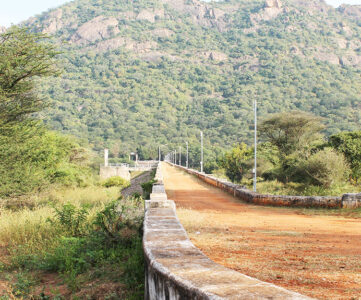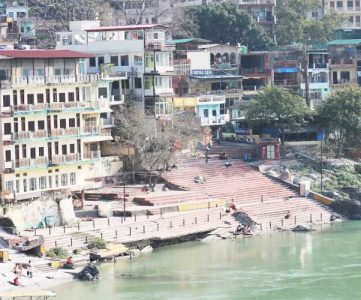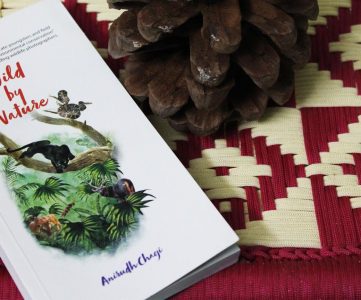The Sahyadris, of the Gondwana land, is known famously as the Western Ghats. Stretching its might of, valleys and ravines, forests and peaks, rivers and waterfalls, is older than the puissant Himalayas. And in these ranges lay tucked, within vastly coffee plantations in the beautiful
And a reticent – Sakleshpur. The Switzerland of Karnataka! One rises to the smells of the aromatic coffee, throughout the year, either the smells of the coffee blooms, or the drying beans in the subtle morning sun, or of the brewing cuppa!
Welcome to the coffee land – unique of growing both the varieties – the robusta and arabica. Coffee is the lifeline of Sakleshpur and the economy, largely, derives it’s living from growing the “brown beans”. With a glean to understand the beans, I visited the plantations and got talking to “planters” who have been in the business of coffee for decades and who are aptly “ sons of the soil”. And I must say, my knowledge got deepened with the most insightful grounding.
“Coffee” for the people of Sakleshpur is “life” and the “ lifeline”, we live coffee everyday of our life and there’s new learning’s, that never ceases…. till we bite the dust! Eloquently quoted by Chirag, a planter with the family growing it for generations. The Arabica fetches us more money and the quality too is better than the robusta, but to the dismal research on the variety, the stem borers play havoc and there’s not much help that the coffee board extends… ironically, Sighs Chirag
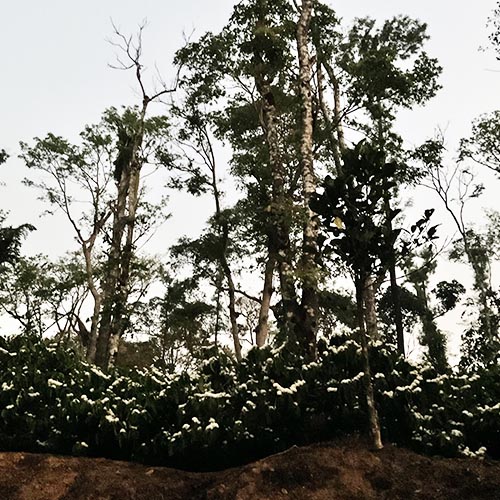
(Picture: At the break of Dawn, Sakleshpur Coffee Estates, with blossoms)
As I write these lines, my mind goes back to the words of the planter and reverberates…. in less than five years the arabica will leave our country, we’ll stop growing them… because the Robusta variety is just “ put the water pick the beans” . Chirag lives with his family in a sprawling 650 acres plantation and calls his place Swarga ( Heaven), where all five elements of nature caress him and keeps his life going, as he Marches on to carry the legacy of a Malnad Coffee Planter- a very proud one at that.

(Picture:The Coffee berries)
All about the browny! Coffee Beans
was fascinated to know that the beans of Coffee in its texture can vary with every estate, with factors such as inches in rainfall affecting the texture and output. How interesting is that?
One differentiates the Robusta and Arabica by the length of the stem and the density of the growth, the longer steamed ones are the Robusta with thicker density and are bushier and the shorter stemmed ones with less bushy density , the Arabica. The robusta is used for black coffee and the arabica for filter coffee . Indian coffee is most sought after in the world because it is shade grown and hand picked. India is also very labour dependent for coffee picking, drying and packing as opposed to outside of the country which has machines to replace the same. Oranges, cardamom and pepper grow interspersed along with coffee in the malnad region. In a plant, there grows three varieties of seeds, the double seeded plantation grade “A” , which is larger in size and the plantation grade “B”, the smaller sized ones. The third and the most sought after one the “ Peaberry”; the single seeded bean fetches the planters the highest price in the market. The beans has protection of two layers of outer skin, the first pulpy layer gets pulled of right after the harvest and allowed to dry with the second layer of protective skin, this skin can keep the coffee bean in tact for one year. Without it the shelf life reduces.

A panoramic view of the Bisle ranges that form the tri junction of districts, extreme left is Pushpagiri and Doddabetta of Kodagu District, in the middle the Kumaraparvatha of Dakshina Kannada and where we stand and to the slight right the Yennikallu and Patla Betta of Hassan District.
The Sahyadris
The Sahyadris are a range of mountains and peaks running parallel to the western coast of the subcontinent, covering Kerala, Tamil Nadu, Karnataka, Goa, Maharashtra and Gujarat. The sleepy Sakleshpur lies in the western edge of the western Ghats and the Deccan plateau and boasts of scenic “bettas” ( hill peaks) One can scale and trek on the many hill routes that lead to peaks and some stunning views including mesmerising sunset experiences. Some of the Bettas ( hills), Hosahalli betta, Patla Betta and Kaginahare Betta can be accessed without prior permissions from the Forest Department. There are other trekking routes to be added in the near future.
Culture And Cuisine
To my greatest surprise This little town boasts of a very cosmopolitan culture. People of different ethnicity live in harmony and support each other. The society is comprised of migrants from Tamil Nadu, Tulu Nadu and Mysore. Planters from Chikamagalur have found place in sakleshpur to grow Coffee and have flourished in their trade. The Brits who grew Coffee here brought in the Mangalorean Catholics, they stayed over and thus came their cultural influence to this region. The Lingayat and the Vokkaligas who live here are from the Mysore strain, subscribing to the Wodeyars and following their rituals, dressing and cuisine. This Cauldron of Culture has evolved in the last 100 years post the British era. With all of them occupying their places, in Sakleshpur and making their indelible mark in terms of cuisine, culture and traditions, this region stands tall in each of their contributions.
Talking of this regions’ great taste, the most delectable , palate watering cuisines, all rounds off with their favourite, their brew of coffee! I tried not to salivate while writing this section up…. Hmmm that’s a task now
Sakleshpur, again threw surprises, with the array and spread of the different flavours, all locally grown, seasonal rationing of their nature’s yields, traditional cooking techniques with subtle seasonings makes the table for this region’s feast.
Sakleshpur is representative of Malenadu ( land of hills) cuisine, a farmers food, as that’s what they consider themselves to be. They are predominantly rice and meat eaters. Their veggies and fruits root about in their backyard. Some classic dishes of this kind, the kesavina Gantu palya or Karkali( Colocasia leaves knotted and cooked down with spices), the Kalale ( Bamboo shoot) curry, Hurali ( Horse Gram) Kattu, Halasina Hannu Hittu ( Jackfruit dumpling), wild raw mango curry and their very own elephant yam, from their estates. The famous rice dishes are the Kadubu and Akki Roti. They love their meats and their all time favourite Pork, the pepper fry is a typical Malenadu style succulent dry dish that adorns their tables along with other fish, chicken and mutton dishes. Their seasonal delicacies are the ones found in the paddy fieds, the soft shelled crabs and Mundel Meenu ( tiny fishes eaten whole). Not to forget the wild mushrooms savoured in the season. How can I forget to mention the fresh palm toddy, the king of all favourites!
And here comes the surprise bit, The Chigli Chutney, made from Red ant nest. The nest is pulled out and washed to make a chutney rich in Vitamin C. It tastes best with Akki Roti, and is preferably a breakfast dish. A must try while in the region!
It’s my duty to finish off this section with a mention of their desserts, the “gase gase” ( poppy seeds) savoury dish , a favourite of the farmers, who could just return home after a heavy day of work and pass out having this healthy sweet dish. The famous Hanbal Chikki, and these are locally produced. One must taste them to know how addictive this sweet dish can be. A visit to the Hanbal Chikki factory, run my Mr Ravi Theja, to taste the classic jaggery chikki, chocolate and mango chikki can be considered a must. The use of local produce to improvise on taste like cardamom chikki and chilli chikki is worth a praise!
Well, I promise to finish this culinary extravaganza of the Sakleshpur folks, with a quote from an old time Planter, Santhosh, we folks love our evening drinks and the company of great conversations and not to forget our very own creation the “Drink Chicken”, a recipe from our minds and the tinge from our wine glasses! I did taste the drink chicken and I kept asking for more.
Did Sakleshpur, engulf me too with its rustic magic? Hmm I think so….
Special Feature
Assertive actions by Planters for sustainability
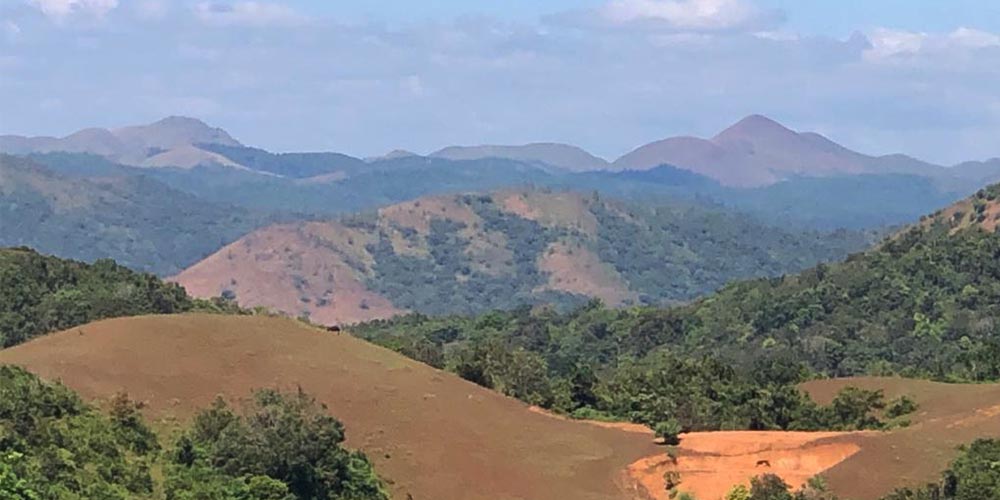
(The Sakleshpur Landscape, of Sholas and Meadows)
I have enjoyed writing this section of the article more than I can explain in words, since it talks about sustainability and conservation. It is humbling to note that for reasons best known to the planters, their conservation consciousness stands tall and the efforts that has gone in to making their coffee world class is notable.
While in a discussion with Charan, an old time coffee grower, who is working to take Sakleshpur Coffee to the Global market, made some strong statements affirming that quality and stringent environmental practices has taken their coffee to be cup tasted by the world famous “Illy” Café brand (illy.com). He continued to inform me of the voluntary association of around 60 planters of Sakleshpur adopting to the practices of “ Rainforest Alliance” (https://www.rainforest-alliance.org/tags/india).
It was rather an insightful and interesting conversation with Mr Manjunath of the Allana group, a person full of emotion and infectious passion for his job. He loves his land and coffee and spoke about the efforts that is going in to making Coffee and Coffee growers align to sustainability standards. The cup of that aromatic brown frothy heavenly drink, to reach us, makes its way through an arduous journey. From, maintaining good soil, to garnering the right shade, to employing good practices in taking care of the coffee labourers, to use of the right chemicals, to conserving other native species and most importantly keeping a watchful eye on those borers and pests. Whoa! That’s a lot of work and commitment.
Furthering my inquisitiveness, I chanced upon talking to a young, educated overseas planter. His energy was striking and his knowledge on coffee rather astounding. Anil Kuchally owns coffee plantations very close to the Bisle range of forests, has employed a large coffee processing facility by emptying his savings for sheer passion to do something unconventional, he buys coffee fruits from planters of the region, processes them and sells. The beans from his estate is branded single origin coffee, named“ Kuchally Coffee”. Our conversation led to me understanding his efforts in saving the arabica variety, which I have heard from few planters is the most difficult to grow and maintain. He has given three acres of his plantation block to experiment on micro climate temperature control, which according to him is the only way to save the plant from stem borers, for which even the Coffee board has no solution.
Anil, was at his highest of emotion when he spoke of climate change and how it’s affecting the quantity of coffee production. Rains playing havoc, extreme weather changes is causing concerns. He has invested his time and energy in artificial irrigation for continued water supply, does intensive farming and is looking at non traditional methods of coffee growing to increase the yield. Finally we ended our fruitful conversation over a lovely quote, “Coffee is like Wine for me. To grow coffee beans or grapEs is easy, what makes for good tasting is the processing. That creates the real magic.”
Well I am drawn to this sleepy town, tucked amidst nature, fabulous and large hearted people and food to die for… I hope you enjoyed reading this piece as much as I enjoyed writing it…..
See you soon Sakleshpur, hang in there!


